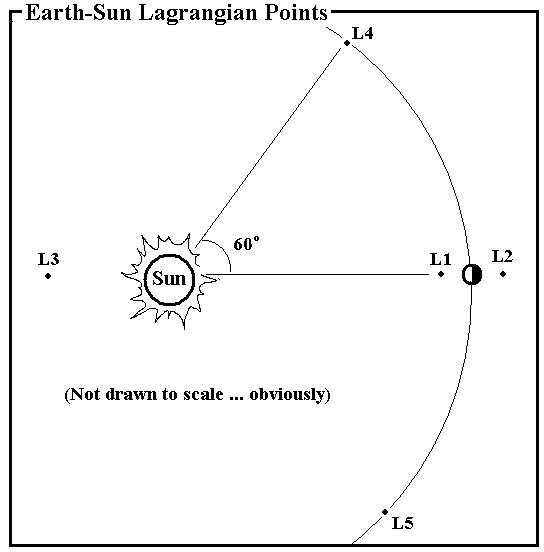Home on Lagrange
Jack Kramer
A particularly handy aspect of celestial mechanics that is extensively used in the space program is something called Lagrangian Points. These are points where the pull of gravity of two large bodies acting on a smaller body, plus centrifugal force, is so equal that the small body is able to remain in a reasonably stable orbit, unless disturbed by another large body. Designated as L1, L2, L3, etc., they're named after Joseph Lagrange, the French mathematician who first pointed out this unique aspect of gravity.
It's easier to understand if we look at examples. Lagrangian Point L1 is the most stable such point in a direct line between the Earth and the sun. At this point, the gravity of the Sun on a small body is offset by the gravity of the Earth. L1 is about four times more distant than the Moon, at about 1/100 of the distance from the Earth to the Sun. If a spacecraft is placed in orbit here between the Earth and the Sun, the opposing pull of the Earth counteracts the effective pull of the Sun, allowing the spacecraft to orbit the Sun more slowly. If the distance is properly chosen, the orbital motion will match that of Earth, allowing a spacecraft to stay in position throughout the Earth's journey around the Sun. Currently two spacecraft are stationed near L1 - ACE, which studies cosmic rays and the solar wind, and SOHO, which observes the Sun.

Around Earth there are a total of five Lagrangian Points. Point L2 is symmetric to L1, but on the opposite, night side of the Earth. NASA positioned its Microwave Anisotropy Probe (MAP) near the L2 point. MAP is a follow-up on the Cosmic Background Explorer (COBE) which in 1992 measured the brightness and wavelength distribution of cosmic background microwave radiation left over from the Big Bang. NASA also plans to place its "Next Generation Space Telescope" (NGST) - the successor to the Hubble telescope - at or near L2.
The L3 point is on the far side of the Sun, invisible from Earth, relatively unstable and of little importance. Of greater interest are the L4 and L5 points on the Earth's orbit but 60° off the Sun-Earth line (viewed from above the north pole, L5 is 60° clockwise from that line, L4 60° counterclockwise).
The Earth-Sun system is not the only place where Lagrangian Points exist. Some observers claim to have detected small asteroids near the L4 and/or L5 points of Mars and Venus, as well as Earth, but the effect is most pronounced at the Lagrangian points of Jupiter. Several hundred so-called Trojan Asteroids are located in the vicinity of Jupiter's L4 and L5 points, orbiting the Sun with the same period as Jupiter. They're known as "Trojan" because their names come from characters in Homer's Iliad.
The Earth-Moon system also has its Lagrangian points, and the L4 and L5 points on the Moon's orbit have been proposed as sites for self-contained space colonies. Science fiction writers have incorporated these points into several of their works.
Originally, I intended this to be one of our short "Astro-Dictionary" items. But as you can see, it's a bit too complex for that abbreviated format! The mathematical proof of these points is long, but if you'd like to learn more about it, check the NASA web site:
http://www-spof.gsfc.nasa.gov/stargaze/Sintro.htm
Let's end with a song that was written in 1978 for potential space colonists at the L4 or L5 Earth-Moon points, to the tune of "Home on the Range":
Home on Lagrange
Oh give me a locus
Where the gravitons focus
Where the three-body problem is solved
Where the microwaves play
Down at 3 degrees K
And the cold virus never evolved
CHORUS:
Home, home on Lagrange
Where the space debris always collects...





